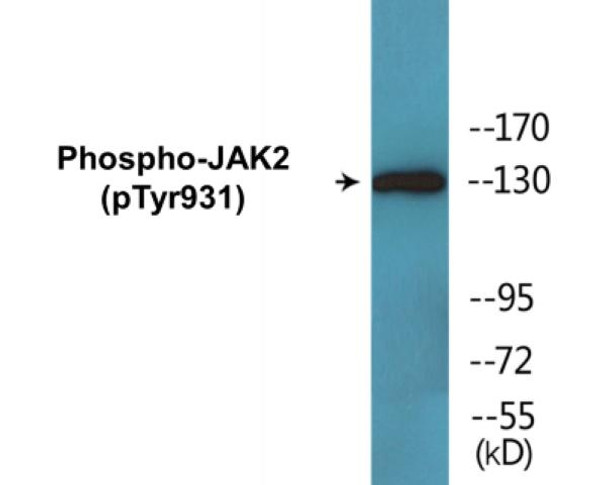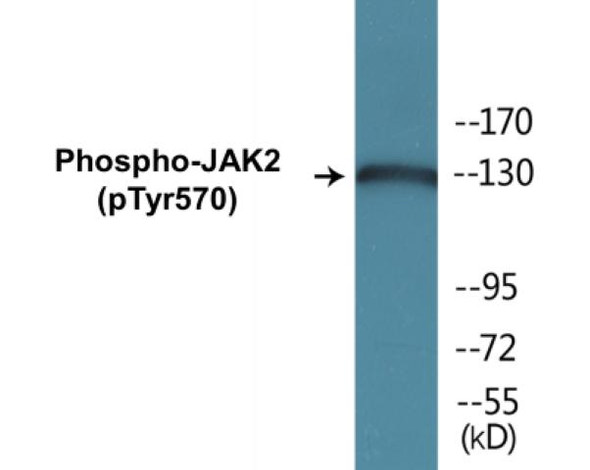JAK2 (Phospho-Tyr931) Colorimetric Cell-Based ELISA Kit
- SKU:
- CBCAB01646
- Product Type:
- ELISA Kit
- ELISA Type:
- Cell Based Phospho Specific
- Research Area:
- Immunology
- Reactivity:
- Human
- Mouse
- Rat
- Detection Method:
- Colorimetric
Description
| Product Name: | JAK2 (Phospho-Tyr931) Colorimetric Cell-Based ELISA |
| Product Code: | CBCAB01646 |
| ELISA Type: | Cell-Based |
| Target: | JAK2 (Phospho-Tyr931) |
| Reactivity: | Human, Mouse, Rat |
| Dynamic Range: | > 5000 Cells |
| Detection Method: | Colorimetric 450 nm |
| Format: | 2 x 96-Well Microplates |
The JAK2 (Phospho-Tyr931) Colorimetric Cell-Based ELISA Kit is a convenient, lysate-free, high throughput and sensitive assay kit that can detect JAK2 protein phosphorylation and expression profile in cells. The kit can be used for measuring the relative amounts of phosphorylated JAK2 in cultured cells as well as screening for the effects that various treatments, inhibitors (ie. siRNA or chemicals), or activators have on JAK2 phosphorylation.
Qualitative determination of JAK2 (Phospho-Tyr931) concentration is achieved by an indirect ELISA format. In essence, JAK2 (Phospho-Tyr931) is captured by JAK2 (Phospho-Tyr931)-specific primary (1ø) antibodies while the HRP-conjugated secondary (2ø) antibodies bind the Fc region of the 1ø antibody. Through this binding, the HRP enzyme conjugated to the 2ø antibody can catalyze a colorimetric reaction upon substrate addition. Due to the qualitative nature of the Cell-Based ELISA, multiple normalization methods are needed:
| 1. | A monoclonal antibody specific for human GAPDH is included to serve as an internal positive control in normalizing the target absorbance values. |
| 2. | Following the colorimetric measurement of HRP activity via substrate addition, the Crystal Violet whole-cell staining method may be used to determine cell density. After staining, the results can be analysed by normalizing the absorbance values to cell amounts, by which the plating difference can be adjusted. |
| Database Information: | Gene ID: 3717, UniProt ID: O60674, OMIM: 147796/187950/254450/263300/600880/601626, Unigene: Hs.656213 |
| Gene Symbol: | JAK2 |
| Sub Type: | Phospho |
| UniProt Protein Function: | JAK2: a non-receptor tyrosine-kinase involved in a specific subset of cytokine receptor signaling pathways, including IL-3, -5 and GM-CSF. Interacts with IL23R, SKB1 and STAM2. It has been found to be constitutively associated with the prolactin receptor and is required for responses to gamma interferon. Mice that do not express an active protein for this gene exhibit embryonic lethality associated with the absence of definitive erythropoiesis. Fusion of Jak2 to TEL1 (ETV6) by t(9;12)(p24;p13) causes myeloproliferative disease in humans and mouse models. The Jak inhibitor AG490 inhibits constitutive Jak2 phosphorylation and causes apoptosis in cells from breast cancer and relapsing acute lymphoblastic leukemia. A single activating mutation is associated with several hematological malignancies. Inhibitor: AG490. |
| UniProt Protein Details: | Protein type:Protein kinase, TK; EC 2.7.10.2; Kinase, protein; Oncoprotein; Protein kinase, tyrosine (non-receptor); TK group; JakA family Chromosomal Location of Human Ortholog: 9p24 Cellular Component: caveola; cytoplasm; cytoskeleton; cytosol; extrinsic to internal side of plasma membrane; lipid raft; nuclear matrix; nucleoplasm; nucleus Molecular Function:acetylcholine receptor binding; ATP binding; growth hormone receptor binding; heme binding; histone binding; insulin receptor substrate binding; interleukin-12 receptor binding; metal ion binding; non-membrane spanning protein tyrosine kinase activity; peptide hormone receptor binding; phosphoinositide 3-kinase binding; protein binding; protein C-terminus binding; protein kinase activity; protein kinase binding; protein-tyrosine kinase activity; Ras guanyl-nucleotide exchange factor activity; receptor binding; SH2 domain binding; type 1 angiotensin receptor binding Biological Process: actin filament polymerization; activation of MAPKK activity; adaptive immune response; apoptosis; axon regeneration; blood coagulation; caspase activation; cell differentiation; cell migration; cell motility; cytokine and chemokine mediated signaling pathway; elevation of cytosolic calcium ion concentration; enzyme linked receptor protein signaling pathway; erythrocyte differentiation; G-protein coupled receptor protein signaling pathway; induction of apoptosis by oxidative stress; innate immune response; JAK-STAT cascade; MAPKKK cascade; mesoderm development; mineralocorticoid receptor signaling pathway; negative regulation of cell proliferation; negative regulation of cell-cell adhesion; negative regulation of DNA binding; negative regulation of heart contraction; negative regulation of neuron apoptosis; peptidyl-tyrosine phosphorylation; platelet-derived growth factor receptor signaling pathway; positive regulation of cell activation; positive regulation of cell differentiation; positive regulation of cell migration; positive regulation of cell proliferation; positive regulation of DNA binding; positive regulation of GTPase activity; positive regulation of inflammatory response; positive regulation of insulin secretion; positive regulation of interleukin-1 beta production; positive regulation of nitric oxide biosynthetic process; positive regulation of nitric-oxide synthase biosynthetic process; positive regulation of peptidyl-tyrosine phosphorylation; positive regulation of phosphoinositide 3-kinase cascade; positive regulation of phosphoprotein phosphatase activity; positive regulation of protein import into nucleus, translocation; positive regulation of transcription factor activity; positive regulation of tumor necrosis factor production; positive regulation of tyrosine phosphorylation of Stat3 protein; positive regulation of tyrosine phosphorylation of Stat5 protein; protein amino acid autophosphorylation; protein amino acid phosphorylation; regulation of apoptosis; regulation of cell proliferation; regulation of inflammatory response; response to antibiotic; response to hydroperoxide; response to lipopolysaccharide; signal transduction; STAT protein nuclear translocation; tumor necrosis factor-mediated signaling pathway; tyrosine phosphorylation of JAK2 protein; tyrosine phosphorylation of STAT protein; tyrosine phosphorylation of Stat1 protein; tyrosine phosphorylation of Stat3 protein; tyrosine phosphorylation of Stat5 protein Disease: Budd-chiari Syndrome; Erythrocytosis, Familial, 1; Myelofibrosis; Polycythemia Vera; Thrombocythemia 3 |
| NCBI Summary: | This gene product is a protein tyrosine kinase involved in a specific subset of cytokine receptor signaling pathways. It has been found to be constituitively associated with the prolactin receptor and is required for responses to gamma interferon. Mice that do not express an active protein for this gene exhibit embryonic lethality associated with the absence of definitive erythropoiesis. [provided by RefSeq, Jul 2008] |
| UniProt Code: | O60674 |
| NCBI GenInfo Identifier: | 12643404 |
| NCBI Gene ID: | 3717 |
| NCBI Accession: | O60674.2 |
| UniProt Secondary Accession: | O60674,O14636, O75297, |
| UniProt Related Accession: | O60674 |
| Molecular Weight: | 130,674 Da |
| NCBI Full Name: | Tyrosine-protein kinase JAK2 |
| NCBI Synonym Full Names: | Janus kinase 2 |
| NCBI Official Symbol: | JAK2 |
| NCBI Official Synonym Symbols: | JTK10; THCYT3 |
| NCBI Protein Information: | tyrosine-protein kinase JAK2 |
| UniProt Protein Name: | Tyrosine-protein kinase JAK2 |
| UniProt Synonym Protein Names: | Janus kinase 2; JAK-2 |
| Protein Family: | Tyrosine-protein kinase |
| UniProt Gene Name: | JAK2 |
| UniProt Entry Name: | JAK2_HUMAN |
| Component | Quantity |
| 96-Well Cell Culture Clear-Bottom Microplate | 2 plates |
| 10X TBS | 24 mL |
| Quenching Buffer | 24 mL |
| Blocking Buffer | 50 mL |
| 15X Wash Buffer | 50 mL |
| Primary Antibody Diluent | 12 mL |
| 100x Anti-Phospho Target Antibody | 60 µL |
| 100x Anti-Target Antibody | 60 µL |
| Anti-GAPDH Antibody | 60 µL |
| HRP-Conjugated Anti-Rabbit IgG Antibody | 12 mL |
| HRP-Conjugated Anti-Mouse IgG Antibody | 12 mL |
| SDS Solution | 12 mL |
| Stop Solution | 24 mL |
| Ready-to-Use Substrate | 12 mL |
| Crystal Violet Solution | 12 mL |
| Adhesive Plate Seals | 2 seals |
The following materials and/or equipment are NOT provided in this kit but are necessary to successfully conduct the experiment:
- Microplate reader able to measure absorbance at 450 nm and/or 595 nm for Crystal Violet Cell Staining (Optional)
- Micropipettes with capability of measuring volumes ranging from 1 µL to 1 ml
- 37% formaldehyde (Sigma Cat# F-8775) or formaldehyde from other sources
- Squirt bottle, manifold dispenser, multichannel pipette reservoir or automated microplate washer
- Graph paper or computer software capable of generating or displaying logarithmic functions
- Absorbent papers or vacuum aspirator
- Test tubes or microfuge tubes capable of storing ≥1 ml
- Poly-L-Lysine (Sigma Cat# P4832 for suspension cells)
- Orbital shaker (optional)
- Deionized or sterile water
*Note: Protocols are specific to each batch/lot. For the correct instructions please follow the protocol included in your kit.
| Step | Procedure |
| 1. | Seed 200 µL of 20,000 adherent cells in culture medium in each well of a 96-well plate. The plates included in the kit are sterile and treated for cell culture. For suspension cells and loosely attached cells, coat the plates with 100 µL of 10 µg/ml Poly-L-Lysine (not included) to each well of a 96-well plate for 30 minutes at 37 °C prior to adding cells. |
| 2. | Incubate the cells for overnight at 37 °C, 5% CO2. |
| 3. | Treat the cells as desired. |
| 4. | Remove the cell culture medium and rinse with 200 µL of 1x TBS, twice. |
| 5. | Fix the cells by incubating with 100 µL of Fixing Solution for 20 minutes at room temperature. The 4% formaldehyde is used for adherent cells and 8% formaldehyde is used for suspension cells and loosely attached cells. |
| 6. | Remove the Fixing Solution and wash the plate 3 times with 200 µL 1x Wash Buffer for five minutes each time with gentle shaking on the orbital shaker. The plate can be stored at 4 °C for a week. |
| 7. | Add 100 µL of Quenching Buffer and incubate for 20 minutes at room temperature. |
| 8. | Wash the plate 3 times with 1x Wash Buffer for 5 minutes each time. |
| 9. | Add 200 µL of Blocking Buffer and incubate for 1 hour at room temperature. |
| 10. | Wash 3 times with 200 µL of 1x Wash Buffer for 5 minutes each time. |
| 11. | Add 50 µL of 1x primary antibodies Anti-JAK2 (Phospho-Tyr931) Antibody, Anti-JAK2 Antibody and/or Anti-GAPDH Antibody) to the corresponding wells, cover with Parafilm and incubate for 16 hours (overnight) at 4 °C. If the target expression is known to be high, incubate for 2 hours at room temperature. |
| 12. | Wash 3 times with 200 µL of 1x Wash Buffer for 5 minutes each time. |
| 13. | Add 50 µL of 1x secondary antibodies (HRP-Conjugated AntiRabbit IgG Antibody or HRP-Conjugated Anti-Mouse IgG Antibody) to corresponding wells and incubate for 1.5 hours at room temperature. |
| 14. | Wash 3 times with 200 µL of 1x Wash Buffer for 5 minutes each time. |
| 15. | Add 50 µL of Ready-to-Use Substrate to each well and incubate for 30 minutes at room temperature in the dark. |
| 16. | Add 50 µL of Stop Solution to each well and read OD at 450 nm immediately using the microplate reader. |
(Additional Crystal Violet staining may be performed if desired – details of this may be found in the kit technical manual.)





